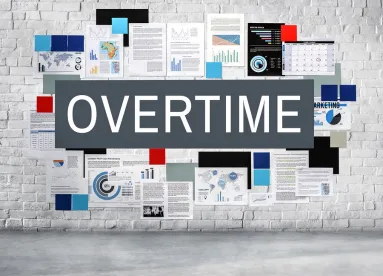The Fair Labor Standards Act (“FLSA”) provides that all employees are entitled to overtime compensation unless they meet the legal standard for one or more “exemptions” from overtime that are identified in the FLSA. For an employee to be exempt from the FLSA’s overtime pay requirement pursuant to the executive, administrative, and professional exemptions (often referred to as the “white collar” exemptions), employees must satisfy both a $455 weekly minimum salary requirement and perform certain exempt-qualifying duties identified in U.S. Department of Labor (“DOL”) regulations. In addition, the “highly compensated employee” exemption provides that the overtime exemption will apply to employees who are paid at least $100,000 per year and perform at least one of the exempt-qualifying duties of an exemption.
The DOL’s New Overtime Rule
On May 18, 2016, the DOL published amendments to its white-collar exemption regulations that would more than double the current $455 minimum to $913 per week (“Final Rule”). In addition, the Final Rule would increase the highly compensated employee exemption threshold from $100,000 to $134,004 per year. The Final Rule would also automatically update the salary threshold levels every three years, beginning in the year 2020. The Final Rule had been scheduled to take effect on December 1, 2016.
Lawsuits Challenging the Final Rule
As many employers are already aware, on September 20, 2016, 21 states and a coalition of business organizations filed separate legal challenges, in the Eastern District of Texas, seeking to invalidate the Final Rule and requesting injunctive relief to effectively block the DOL’s December 1, 2016, effective date. On November 22, 2016, just over a week prior to the expected implementation of the Final Rule, U.S. District Judge Amos Mazzant III issued a nationwide preliminary injunction blocking the DOL from implementing the Final Rule. The decision held that the plaintiffs satisfied all prerequisites for a preliminary injunction and that they also established a prima facie case that the DOL’s salary level under the Final Rule and the automatic updating mechanism are without statutory authority. While the court’s preliminary injunction is a strong indicator that the court would ultimately find the Final Rule unlawful, the underlying merits of the lawsuit and the constitutionality of the Final Rule have yet to be decided.
On December 1, 2016, the DOL filed a notice of appeal to the U.S. Court of Appeals for the Fifth Circuit. In addition to appealing Judge Mazzant’s order, the DOL may file a motion to stay the order in order to lift the injunction pending the appeal to the Fifth Circuit.
Depending on the timing of the DOL’s appeal, it is possible that any decision would be issued after President-elect Trump’s inauguration, which could very well affect the DOL’s decision to continue its appeal or instead comply with the preliminary injunction.
What Employers Should Do Now
Since the DOL published the Final Rule this past May, many businesses have conducted comprehensive audits of their currently exempt workforce to determine whether any salary adjustments would be necessary to maintain compliance with the Final Rule. In fact, many businesses have already implemented certain changes.
For businesses that have already implemented or announced changes to their classification or pay scales, it is important to consider the potential employee relations impact that could result by rescinding salary raises or changes in exempt status. Businesses that have already implemented changes have likely considered the financial impact of the reclassification decisions and have been able to accommodate those planned changes in a financially sound manner. Therefore, any potential employee relations risks may outweigh the actual financial impact of increased salaries for exempt employees or paying overtime to newly reclassified non-exempt employees. Businesses in these circumstances may also be able to absorb these new costs by offsetting future salary increases, bonuses, or other forms of compensation.
Businesses that have not yet implemented or announced changes should consider whether to take a “wait and see approach” pending resolution of the Final Rule litigation, or to begin proactively reviewing FLSA compliance under the current exemption criteria (including the unchanged duties test criteria).
In addition, regardless of the future of the Final Rule, it is important for businesses to be mindful of any current or impending relevant state law requirements that set forth standards for exemption that are more exacting than the current federal requirements. For example, states such as New York and California maintain their own minimum salary thresholds that exceed current federal requirements and are expected in the coming years to exceed the minimum salary threshold prescribed by the Final Rule.




 />i
/>i

